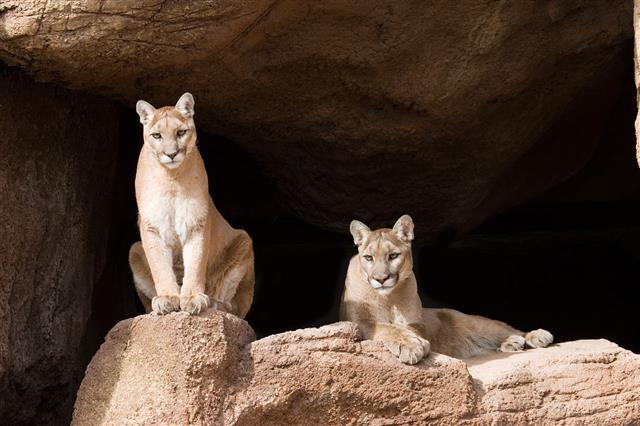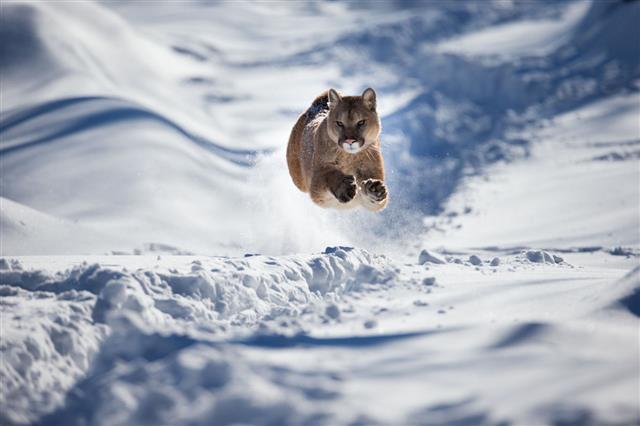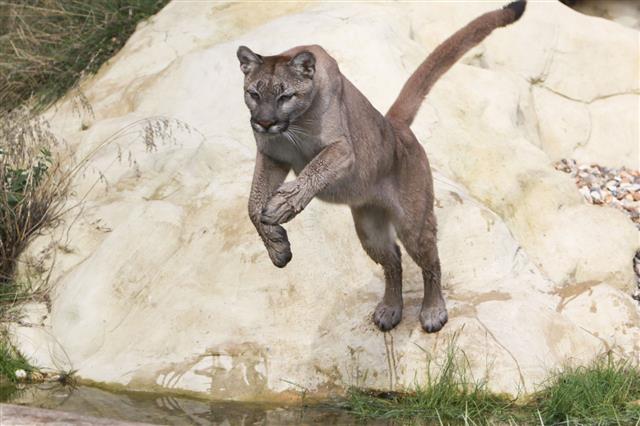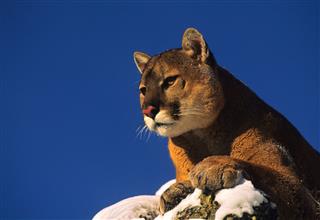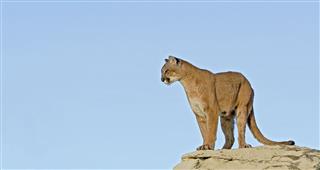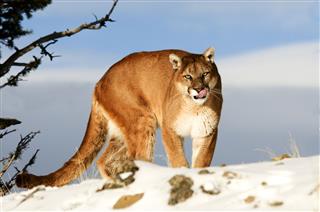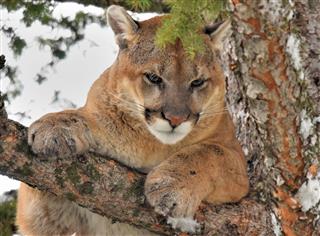
The cougars or mountain lions are animals that are found in a wide range of diverse habitats spanning across 28 countries in the western hemisphere.
The cougars or mountain lions (Puma concolor) are mammals that belong to the Felidae (cat) family. They are the most widely distributed amongst all the wild cats in the western hemisphere. They have a very wide range extending from Yukon in Canada to the southern Andes of South America. Hence, across different geographic regions, cougars are called by various names like a puma, deer cat, mountain lion, mountain devil, red tiger, king cat, sneak cat, catamount, Mexican lion, panther, mountain screamer, and silver lion.
These animals are more related to small cats than the big ones. They are the largest among small cats and are not classified as big cats, in spite of their large size. Unlike the big cats, cougars cannot roar but can growl and chirp like small cats. They have muscular limbs, large feet, are often plain-coloured (gray or tan), and have a pink nose.
In the English language alone, there are over 40 names for cougars, which earns it the distinction of having the most names for a single animal. The cougar is the fourth heaviest cat in the world, after the tiger, lion, and jaguar. In America, it is the second heaviest wildcat, after the jaguar.
Cougar Distribution
As mentioned earlier, cougars have a very wide range covering parts of Canada, United States and most of the South American countries. These animals used to be found in almost all parts of the United States, but due to human encroachment, they have suffered a major habitat loss; this has caused the population of cougars to reduce drastically. They have quite literally been eliminated from most regions of the country. Though the cougar is listed as a ‘least concern’ species, its sub-species – the Florida panther is classified as ‘critically endangered’.
Where Do Cougars Live?
Cougars adapt to a wide range of habitats at sea level to the ones at an elevation of around 10,000 to 15,000 feet. They thrive in habitats across the cold woods of Canada, the rainforests of Brazil, the western country of the United States and the vast grassy plains (pampas) of Argentina. Cougars can survive in tropical forests, swamps, grasslands, mountain conifer forests, desert scrub, and any location with adequate cover and prey.
Cougars prefer dense forests, coastal swamps, rocky cliffs, and mountain ranges as their habitat, and tend to avoid areas that are open, lack adequate vegetation and stalk cover. It has been observed that the diverse habitats of cougars have something or the other in common. Though they may look entirely different, there are certain underlying factors that make a particular region favorable for cougars or mountain lions. They include, abundance of prey, prey vulnerability, stalk cover, etc.
Adequate Cover:
One of the elements that is common for different cougar habitats is sufficient cover for the animal to hide. Such a cover is vital for hunting and for protecting the young ones. As far as hunting is concerned, the cougar tries to stay out of sight, till it reaches a short distance from the prey. Once the prey is near, the cougar pounces on it and kills it. So, till it reaches the prey, the cougar needs some sort of cover. So most of the cougar habitats offer such cover in the form of thick vegetation, rocks and boulders, etc. A good cover also means protection for its young ones from predators.


Abundance of Prey:
It is natural for any animal to stay in places where they get enough food. In case of cougars, deer are the most preferred prey. So cougar habitats often coincide with the habitat of deer, and animals like, rabbits, moose, sheep, porcupine, capybara, mice, squirrels, etc. Both deer and cougars like dense vegetation. While for cougars, such vegetation offers stalk cover, for deer, it is an escape cover. Deer too need some cover to escape from predators. While deer look for a specific type of vegetation as forage, for cougars, it is the density (and not the type) of the vegetation that matters. These wild cats require somewhat dense vegetation that keeps them out of sight of the prey, at the same time, allows them to see the movements of the prey.
Territory
Cougars are solitary animals with individual territories. Only mothers roam about with their cubs. They have large territories, which are usually oval or circular in shape. While males have very large territories, the home range of females are smaller and may overlap with the territories of more than one male. The area of cougar territories depends on the abundance of prey and vegetation. If there is a scarcity of prey in a particular area, the size of individual territories would be large.
Cougar Home
Cougars don’t have permanent dens, but they are often found resting in caves, among rocky outcrops, and in dense vegetation. Cougars have a tendency to migrate to the mountains in winter, mainly for hunting.
Life Span
Cougars have a lifespan of 8 to 13 years in the wild and up to 20 years in captivity.
Sub-species
According to recent studies, there are around six sub-species of cougars. The sub-species are as follows Florida panther, North American cougar, Eastern cougar, Argentine cougar, Northern South American cougar, Costa Rican cougar.
To conclude, cougars are animals that were once commonly seen in almost all parts of both South and North America. Though the extent of their habitat has been reduced, cougars have escaped the threat of extinction, mainly due to their highly adaptable nature. However, conservation efforts are still underway, so that their numbers do not go down further.







